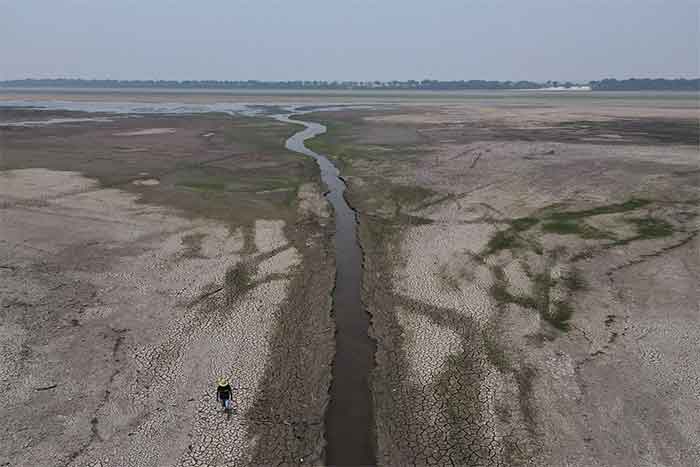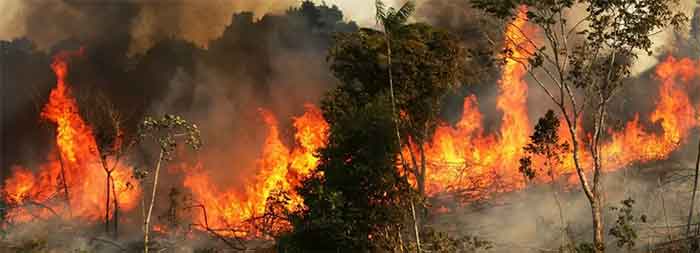
A new 40-year study discovered the eye-opening fact that what happens in the Amazon Rainforest impacts the entire Earth system. This puts an exclamation point on the fact that the Amazon Rainforest, the planet’s most crucial source of life support, is in deep trouble mainly because of massive deforestation.
The Amazon River Basin is the world’s largest rainforest, larger than the next two largest rainforests combined, the Congo Basin and Indonesia, and roughly the size of the forty-eight contiguous United States covering 40% of South America including parts of Brazil, Bolivia, Peru, Ecuador, Colombia, Venezuela, Guyana Suriname and French Guiana.
According to the World Wildlife Fund (WWF): “The Amazon is of vital importance because people around the world, as well as locally, depend on the rainforest. Not just for food, water, wood and medicines, but to help stabilize the climate—around 76 billion tonnes of carbon is stored in the Amazon rainforest., The trees in the Amazon also release 20 billion tonnes of water into the atmosphere per day, playing a critical role in global and regional carbon and water cycles.”
The 40-year study links Amazonian deforestation to reduced Tibetan snows and Antarctic ice loss. Both carry serious consequences, respectively, loss of nature’s water towers for millions of people as sea levels rise everywhere.
The study analyzed 40 years of air temperatures, concluding that the climate of the planet is a function of several disparate forces that interact such that a new planetary state hostile to life may be underway. The study analyzed hourly near-surface temperatures accumulated by the European Centre for Medium-Range Weather Forecast across a global grid of 65,000 locations for a 40-year cycle.
Specifically, the study demonstrated how air temperature changes in one region rippled through the climate system to affect temperatures in other parts of the globe. For example: “Deforestation in the Amazon likely influences the Tibetan Plateau via a convoluted 20,000-kilometer (12,400-mile) pathway driven by atmospheric and oceanic circulation patterns. The study suggests that a healthy, functioning Amazon is crucial not only for the regional climate in Brazil, but for the whole Earth system.” (Source: Claire Asher, Amazon Deforestation Linked to Reduced Tibetan Snows, Antarctic Ice Loss: Study, Mongabay Series, March 8, 2023).
They’ve identified potential tipping points of the major planetary ecosystems that could trigger one after another, thereby changing life in multitudes of undesirable ways. The catalyst appears to be the Amazon Rainforest.
According to Jingfang Fan, Earth System Scientist at Beijing Normal University and the Potsdam Institute, several tipping elements of the planet could trigger one after another in a massive cascade of uncontrollable events, i.e., the Amazon Rainforest biome, the East and West Antarctic ice sheets, Arctic permafrost, and the Great Barrier Reef.
According to Teng Lui, Ph.D., at Beijing Normal University: “This is the first time that the (mathematical) theory of complex networks has been applied in the context of (far distant) tipping points… We found that the Amazon Rainforest exhibits significant teleconnection with other tipping elements,” Ibid.
The study identified “strong correlation” between temperature anomalies in the Amazon and the Tibetan Plateau, roughly 15,000 kilometers (9,300 miles) apart. The data affirmed anomalously warm temperatures in Amazon and Tibet coincided over the past 40 years. Moreover, the study identified the same relationship with the Amazon and Antarctica. (Source TC Liu, et al, Teleconnections Among Tipping Elements in the Earth System, Nature Climate Change, 2023)
“Teleconnections describe remote connections between components of the complex climate system and reflect the transportation of energy or materials on global scale. The great-circle distances of teleconnections are typically thousands of kilometres,” Ibid.
Indeed, the study supports prior studies suggesting that a healthy, or conversely unhealthy, ecosystem in the Amazon is not only impactful for the region but equally for the entire Earth system.
Of major concern, according to the World Wildlife Fund, as of 2022, thirty-five percent (35%) of the Amazon Rainforest is either totally lost or highly degraded. This fact is supportive of calling for a worldwide cooperative effort to take whatever remedial steps necessary, including a halt to human deforestation.
Another study: Amazon Against the Clock: A Regional Assessment on Where and How to Protect 80% by 2025 published by the Amazon Network of Georeferenced Socio-Environmental Information, more all-inclusive than the WWF study, claims 26% of the entire Amazonian territory shows evidence of deforestation and degradation of which 20% is categorized as irreversible and 6% highly degraded. According to the study: “Of the nine countries that make up the Amazon basin, Brazil and Bolivia have the largest amounts of destruction and, as a result, ‘savannization is already taking place in both countries.”
“In the February 2020 edition of Science Advances, Professors Thomas Lovejoy, senior fellow of the United Nations Foundation, and Carlos Nobre, climate scientist from the Institute of Higher Studies of the University of São Paulo, warned that the loss of just 20 to 25 percent of the rainforest could send the Amazon to a point of no return, marking an unstoppable transition to a drier, savanna-like ecosystem.” (Source: The Amazon Approaches Its Tipping Point, The Nature Conservancy, August 20, 2020). Dr. Thomas Lovejoy (1941-2021) and Dr. Carlos Nobre have long been considered the world’s leading experts on the Amazon.
“There are already some solutions being implemented under the principle that nature and people can thrive together. For example, in São Félix do Xingú in the Brazilian state of Pará, TNC supports a project called Cacau Mais Sustentavel. One of its objectives is to assist local farmers in adopting more sustainable practices, such as planting native cocoa trees in previously degraded lands to avoid further deforestation. Such agroforestry systems entail planting crops and native trees side by side to reforest degraded lands,” Ibid.
Meanwhile, in a stark contrast to the forces of nature, the massive rainforest is undergoing massive commercialization: (1) 600 infrastructure projects on rivers (2) twenty new highways planned (3) four hundred operating or new dams in planning stages, and (4) large-scale mining operations. (WWF)
According to Living Amazon Report 2022, World Wildlife Fund publication, November 8, 2022: “The situation has begun to show signs of nearing a point of no return: (1) Seasons are changing (2) Surface water is being lost (3) Rivers are becoming increasingly disconnected and polluted, and (4) Forests are under immense pressure from increasingly devastating waves of deforestation and fire.”
Statista claims: “In 2022, more than 145,000 wildfire outbreaks were reported in the Legal Amazon region in Brazil.” As a rule, fires do not naturally occur in humid, dripping-wet rainforests.
Fire and the human footprint behind it are challenging 30% of the world’s most precious species whilst upsetting the balance of nature across the world by wantonly degrading the biggest domino of the planet.
Robert Hunziker is a journalist from Los Angeles













































